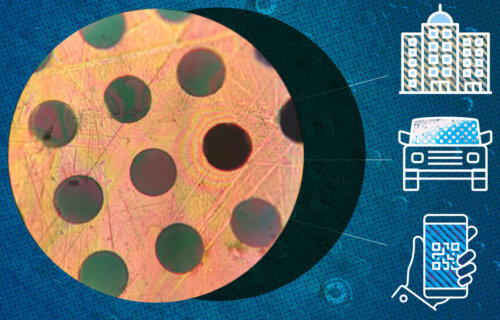
CAMBRIDGE, Mass. — Scientists at MIT have developed a material that is as light as plastic — but stronger than steel. They believe the material could revolutionize the car, mobile phone and building industries.
The easily manufactured substance – up to six times more difficult to break than bulletproof glass – is the result of an engineering feat previously thought to be impossible. It is a two-dimensional polymer that self-assembles into sheets, unlike all other polymers, which form one-dimensional, spaghetti-like chains.
Until now, scientists believed it was impossible to induce polymers to form 2D sheets. Now, its developers hope the material could be used as a lightweight, durable coating for car parts or mobile phones. It could also serve as a worthy candidate for the construction of office buildings, bridges or other structures.
“We don’t usually think of plastics as being something that you could use to support a building, but with this material, you can enable new things,” says senior author Michael Strano, a professor of chemical engineering at MIT, in a statement. “It has very unusual properties and we’re very excited about that.”
The researchers filed for two patents on the pioneering process they used to generate the material.
Birth of 2DPA-1
So how did this groundbreaking substance come to be? Polymers, which include all plastics, consist of chains of building blocks called monomers. The chains grow by adding new molecules onto their ends. Once formed, polymers can be shaped into three-dimensional objects, such as water bottles, using injection molding. Experts have long believed that if polymers could be induced to grow into a two-dimensional sheet, they should form extremely strong, lightweight materials.
However, many decades of work led to the conclusion that it was impossible to create such sheets.
One reason was that if just one monomer rotates up or down, out of the plane of the growing sheet, the material will begin expanding in three dimensions and the sheet-like structure will be lost. However, in the new study, Strano and his colleagues came up with a new polymerization process that allows them to generate a two-dimensional sheet called a polyaramide.
For the monomer building blocks, they use a compound called melamine, which contains a ring of carbon and nitrogen atoms. Under the right conditions, the monomers can grow in two dimensions, forming discs. Strano explains that these discs stack on top of each other, held together by hydrogen bonds between the layers, which make the structure very stable and strong.
“Instead of making a spaghetti-like molecule, we can make a sheet-like molecular plane, where we get molecules to hook themselves together in two dimensions,” says Strano. “This mechanism happens spontaneously in solution, and after we synthesize the material, we can easily spin-coat thin films that are extraordinarily strong.”
Because the material self-assembles in solution, Strano says it can be made in large quantities by simply increasing the quantity of the starting materials. The researchers showed that they could coat surfaces with films of the material, which they call 2DPA-1.
“With this advance, we have planar molecules that are going to be much easier to fashion into a very strong, but extremely thin material,” says Strano.
Revolutionary material ‘can completely prevent water or gases from getting through’
The researchers write that the new material’s elastic modulus – a measure of how much force it takes to deform a material – is between four and six times greater than that of bulletproof glass. They also claim that its yield strength – how much force it takes to break the material – is twice that of steel, even though the material has only about one-sixth the density of steel.
Strano says that another key feature of 2DPA-1 is that it is impermeable to gases. “While other polymers are made from coiled chains with gaps that allow gases to seep through, the new material is made from monomers that lock together like Lego, and molecules cannot get between them,” he adds. “This could allow us to create ultrathin coatings that can completely prevent water or gases from getting through. This kind of barrier coating could be used to protect metal in cars and other vehicles, or steel structures.”
The study’s findings are published in the journal Nature. The authors are now studying in more detail how the material is able to form 2D sheets. They’re also experimenting with changing its molecular make-up to create other new materials.
South West News Service writer Stephen Beech contributed to this report.

All these fantastic inventions should be made available to children at an early age, and to the general public where more ideas and innovation will occur. There should be few secrets in our world especially on tech which will assist us to evolve to a much greater level. Imagine a society like that!
However, many innovations are kept from society, used for nefarious purposes (military, intelligence) or are incrementally released over time under capitalism. We could be so great sharing and understanding this together.